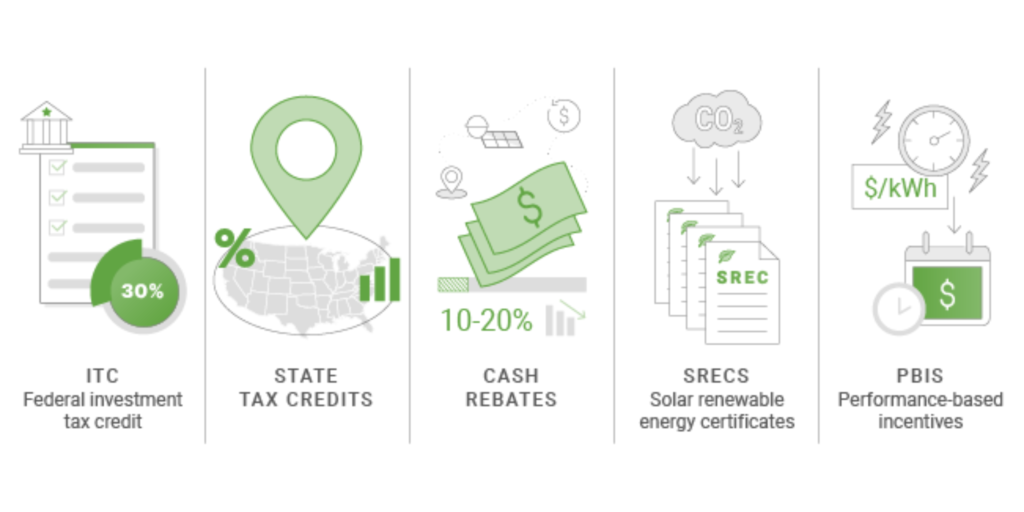
Renewable energies like Solar Power have become increasingly popular in the United States. Individual homeowners and businesses seek to reduce their carbon footprint and lower their electricity bills. However, before initiating the journey of installing solar panels, it’s essential to understand the costs involved, potential savings, and available rebates. This article aims to provide an insightful overview of these aspects to help you make informed decisions about transitioning to solar energy.
Introduction to Solar Panels
- Solar panels, also known as photovoltaic (PV) panels, capture sunlight and convert it into electricity through the photovoltaic effect.
- These panels consist of solar cells that absorb sunlight and produce direct current (DC) electricity.
- This DC electricity is subsequently transformed into alternating current (AC) via an inverter, which powers residences, commercial buildings, and other structures.
Factors Affecting Solar Panel Costs
Type and Quality of Panels
- The type and quality of solar panels play a significant role in determining the overall cost of a solar panel system.
- While standard polycrystalline panels are more affordable, monocrystalline panels are more efficient but come at a higher price point.
System Size
- The energy usage of the property and the volume of required space on the rooftop will determine the size of the solar panel system.
- Larger systems will have higher initial costs, but they may help to save more money over time.
Location
- The cost of installing solar panels is also influenced by the location of the property.
- Factors such as local climate, sunlight exposure, and regulatory requirements can impact installation costs.
Government Incentives and Rebates
- The availability of government rebates and incentives is one of the major factors affecting the price of solar panels.
- At present, the federal government offers 30% of the system cost as the solar investment tax credit (ITC).
- In addition, a lot of states and localities provide further discounts and rewards.

Costs Associated with Installing Solar Panels
Initial Installation Costs
- A typical 6kW system (enough for many homes) costs between $8,500 and $30,500 after the federal tax credit, with an average of $12,700.
- Solar systems are often priced per watt (W), with an average price of $3-$5 per watt before incentives.
- The cost can vary based on system size. A 10kW system for a larger home might cost around $29,410 before incentives.
Additional Expenses
- In addition to the cost of the panels, there are other expenses to consider, such as mounting equipment, wiring, inverters, and installation permits.
- These additional costs can add up to 20-30% to the total cost of the system.
Savings From Solar Panels
Reducing Electricity Bills
By generating their electricity, homeowners and businesses can reduce or eliminate their dependencies on traditional power supply companies, resulting in lower monthly electricity bills.
Return on Investment (ROI)
- Even though the initial cost of solar panels may appear high, it’s important to think about the savings and return on investment over the long run.
- Throughout its 10- to 20-year lifespan, solar panels can provide a sizable return on investment.
Rebates and Incentives Available in the US
Federal Tax Credits
Businesses and homeowners can deduct a portion of the cost of installing solar panels from their federal taxes
Going solar can save you even more money upfront, thanks to Government incentives, which can cover up to 30% of the system cost.
State and Local Incentives
- In addition to federal incentives, many states and local municipalities offer separate incentives and rebates for installing solar panels.
- These incentives can further reduce the one-time cost of going solar.
Environmental Benefits of Solar Panels
- Solar panels not only save money but also have a positive impact on the environment by lowering greenhouse gas emissions, lowering dependencies on fossil fuels, and slowing down global warming
- It creates a positive impact towards a more sustainable future for future generations.
Conclusion
Solar Energy offers significant long-term savings and environmental benefits, making it a smart and long-term investment for homeowners and business houses in the United States Of America.
FAQs
Q: How long do solar panels last?
Ans: Solar panels typically have a lifespan of 25 to 30 years, with most manufacturers offering warranties of 20 to 25 years on their products. Like SunLife offers 25 years of guaranteed life of solar energy, that they will install in a home.
Q: How much money can I save with solar panels?
Ans: Several variables, such as your energy usage, the size of your system, and the available incentives, affect how much money you can save with solar panels.
Nonetheless, during their solar panel installation, homeowners can usually save thousands of dollars.
Q: Do solar panels increase property value?
Ans: Indeed, research indicates that houses including solar panels typically fetch a higher price when they sell, with estimates indicating a $10,000 to $20,000 increase in resale value.
Would you like to explore solar panel costs, savings, and rebates! Get a FREE consultation from the experts of SunLife. Visit https://sunlifenow.com/ or call us at +1 833-478-6669 to learn more and make the switch to sustainable energy today!
Source: Forbes: https://www.forbes.com/home-improvement/solar/cost-of-solar-panels/
SolarReviews: https://www.solarreviews.com/solar-panel-cost
This Old House: https://www.thisoldhouse.com/solar-alternative-energy/reviews/solar-panel-cost
EnergySage: https://www.energysage.com/local-data/solar-panel-cost/



